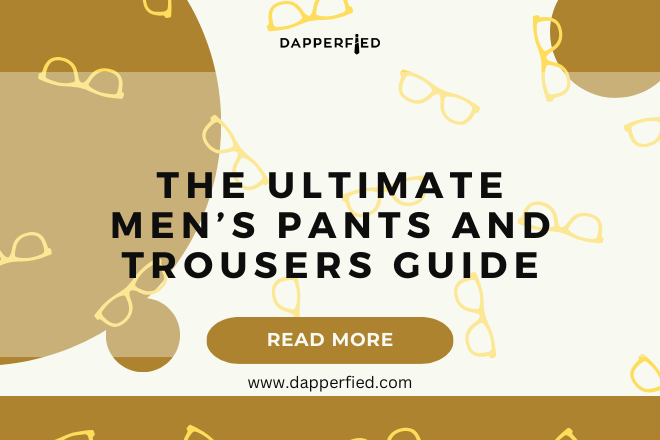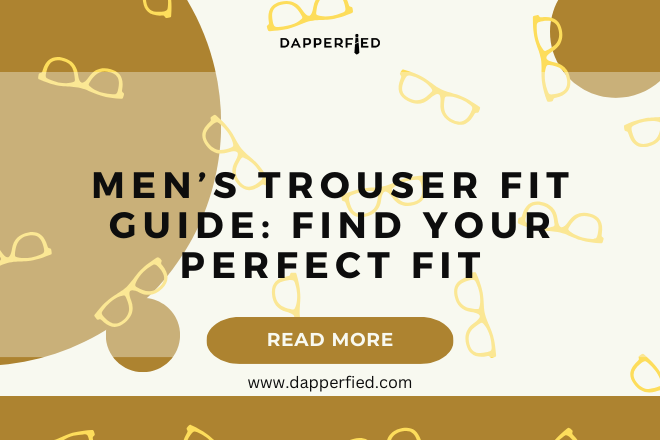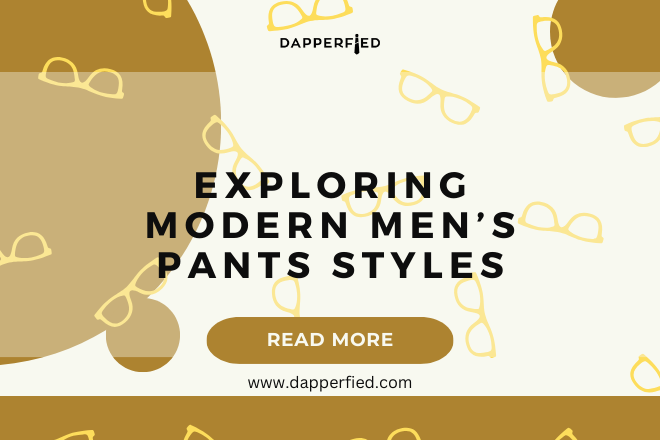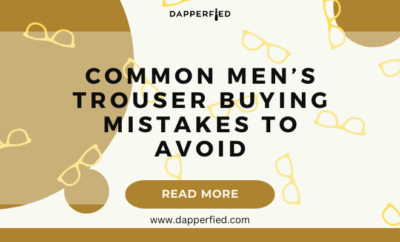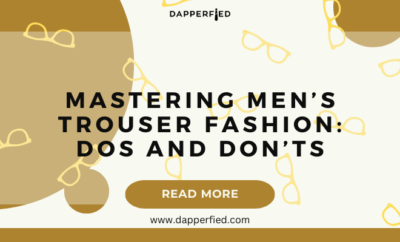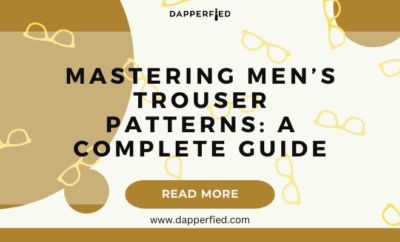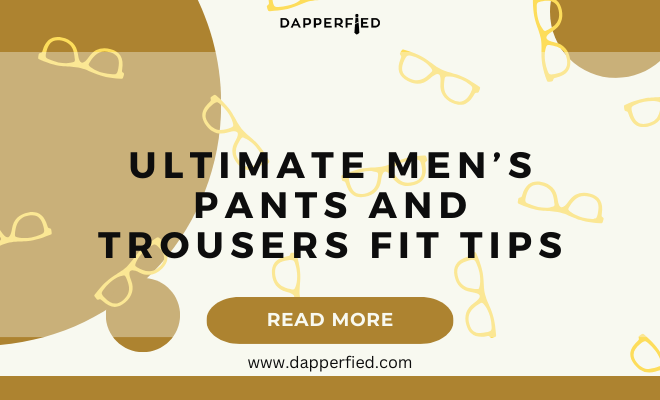
Men's Style
Ultimate Men’s Pants and Trousers Fit Tips
When it comes to finding the perfect pair of pants, understanding the different fits available is crucial. There are several popular fits to consider, including slim fit, straight fit, relaxed fit, and bootcut. Slim fit pants are designed to hug the body closely, providing a sleek and modern look. These are ideal for individuals who prefer a more tailored and fitted silhouette. On the other hand, straight fit pants offer a more traditional and classic look, with a straight leg that provides a timeless appeal. This fit is versatile and can be dressed up or down for various occasions. Relaxed fit pants are roomier in the seat and thighs, offering a more comfortable and casual option for everyday wear. Finally, bootcut pants feature a slight flare at the hem, making them perfect for wearing with boots or heels. Understanding the differences between these fits will help you choose the style that best suits your body type and personal preferences.
In addition to the various fits available, it’s important to consider the rise of the pants. The rise refers to the distance between the crotch and the waistband and can greatly impact the overall fit and comfort of the pants. Low-rise pants sit lower on the hips and are often considered more modern and trendy, while high-rise pants sit at or above the natural waist, providing a more classic and flattering look. Mid-rise pants fall somewhere in between, offering a balanced and versatile option for many body types. Understanding the different rises available will help you find a pair of pants that not only looks great but also feels comfortable and flattering on your body.
Key Takeaways
- Understanding Different Fits: Different fits, such as slim, regular, and relaxed, cater to different body types and style preferences.
- Choosing the Right Waist Size: The waist size of your pants should be comfortable and allow for movement without being too tight or too loose.
- Finding the Perfect Inseam Length: The inseam length should be just right, neither too long nor too short, to ensure a polished look.
- Selecting the Best Leg Shape: Consider the leg shape, such as straight, tapered, or bootcut, to complement your body type and personal style.
- Considering Fabric and Material: The fabric and material of your pants can impact comfort, durability, and overall appearance, so choose wisely based on your needs and preferences.
- Tailoring and Alterations: Tailoring and alterations can help achieve a perfect fit and elevate the look of your pants.
- Styling Tips for Different Occasions: Different occasions call for different styling approaches, so consider the dress code and overall aesthetic when choosing pants for an event or activity.
Choosing the Right Waist Size
Selecting the right waist size is essential for finding pants that fit well and feel comfortable. When choosing the waist size, it’s important to consider both your natural waist measurement and the fit of the pants. For a tailored and fitted look, opt for a waist size that closely matches your natural waist measurement. This will ensure that the pants sit snugly at your waist without feeling too tight or constricting. If you prefer a more relaxed fit, consider sizing up to allow for a looser and more comfortable feel around the waist. Additionally, keep in mind that different brands and styles may have varying waist measurements, so it’s important to try on different sizes to find the best fit for you.
It’s also important to consider how the waistband is constructed. Some pants feature elastic or adjustable waistbands, which can provide added flexibility and comfort. These are ideal for individuals who may fluctuate in weight or prefer a customizable fit. Additionally, paying attention to details such as belt loops and button closures can also impact the overall fit and style of the pants. By choosing the right waist size and considering these additional factors, you can ensure that your pants not only fit well but also provide the comfort and flexibility you need for everyday wear.
Finding the Perfect Inseam Length
Finding the perfect inseam length is crucial for achieving a polished and well-proportioned look. The inseam refers to the measurement from the crotch to the hem of the pants and can greatly impact how the pants fit and drape on your body. When it comes to determining the right inseam length, there are several factors to consider. First, think about the type of shoes you plan to wear with the pants. For a classic and versatile option, aim for a length that grazes the top of your shoes without dragging on the ground. This will create a clean and tailored appearance that works well with both dress shoes and casual footwear.
Additionally, consider your personal style preferences when choosing the inseam length. For a more fashion-forward look, you may opt for a slightly shorter inseam that allows for some ankle exposure, perfect for showcasing statement footwear or adding a modern twist to your outfit. On the other hand, a longer inseam can create a more traditional and formal look, ideal for professional settings or more conservative ensembles. By taking these factors into account, you can find the perfect inseam length that complements your style and ensures that your pants fit and flatter your body.
Selecting the Best Leg Shape
| Leg Shape | Pros | Cons |
|---|---|---|
| Straight | Sturdy and stable | May look bulky |
| Tapered | Elegant and modern | Less stable |
| Cabriole | Classic and decorative | May be less practical |
The leg shape of pants plays a significant role in determining their overall style and silhouette. There are several popular leg shapes to consider, including tapered, wide-leg, flared, and cropped. Tapered pants feature a narrower leg opening that gradually tapers towards the ankle, creating a sleek and tailored look. This leg shape is versatile and works well for both casual and formal outfits, providing a modern and polished appearance. Wide-leg pants, on the other hand, offer a more relaxed and flowy silhouette with a wider leg opening that drapes away from the body. This style is perfect for creating a bohemian or retro-inspired look, offering comfort and movement while still looking chic.
Flared pants feature a dramatic flare at the hem, adding a touch of vintage-inspired flair to any outfit. This leg shape is ideal for making a statement and creating a bold, fashion-forward look. Finally, cropped pants have a shorter length that hits above the ankle, offering a fresh and modern take on traditional pant styles. This leg shape is perfect for showcasing stylish footwear and adding an unexpected twist to your ensemble. By understanding the different leg shapes available, you can choose the style that best suits your personal taste and complements your body type.
In addition to considering leg shapes, it’s important to think about how the pants fit through the thighs and knees. Some styles may feature a slim or straight fit through these areas, while others may offer a more relaxed or wide-leg silhouette. By paying attention to these details, you can ensure that your pants not only look great but also provide the comfort and flexibility you need for all-day wear.
Considering Fabric and Material
When selecting pants, it’s important to consider the fabric and material to ensure that they not only look great but also provide comfort and durability. There are several popular options to choose from, including cotton, denim, wool, polyester, and more. Cotton pants are lightweight and breathable, making them ideal for warm weather or casual wear. Denim is a durable and versatile choice that works well for both casual and semi-formal outfits, offering a timeless appeal that never goes out of style. Wool pants are perfect for cooler temperatures, providing warmth and sophistication with a luxurious feel.
Polyester pants offer wrinkle resistance and easy care, making them ideal for travel or busy lifestyles. Additionally, consider details such as stretch or performance fabrics, which can provide added flexibility and comfort for active individuals or those who prefer a more relaxed fit. By considering these factors, you can choose pants that not only look stylish but also meet your practical needs for everyday wear.
It’s also important to pay attention to details such as texture and finish when selecting pants. Some fabrics may have a smooth or polished appearance, while others may feature a textured or matte finish. These details can greatly impact the overall look and feel of the pants, allowing you to create different aesthetics depending on your personal style preferences.
Tailoring and Alterations

Even when you find a pair of pants that fits well off the rack, it’s common to require some tailoring or alterations to achieve the perfect fit. Whether it’s adjusting the hem length, taking in the waistband, or tapering the legs, tailoring can make a significant difference in how your pants look and feel on your body. When considering alterations, it’s important to work with a skilled tailor who can provide expert advice and precise adjustments to ensure that your pants fit flawlessly.
In addition to basic alterations, there are also custom tailoring options available for individuals who want to create bespoke pants that are tailored specifically to their measurements and preferences. This allows for complete control over details such as fit, fabric, and style, resulting in a truly personalized garment that reflects your individuality.

Styling Tips for Different Occasions
Once you’ve found the perfect pair of pants, it’s important to consider how to style them for different occasions. For formal events or professional settings, opt for tailored trousers in classic colors such as black, navy, or charcoal gray. Pair them with a crisp button-down shirt or blouse for a polished look that exudes sophistication.
For casual outings or everyday wear, consider versatile options such as slim-fit jeans or chinos in neutral tones like khaki or olive green. These can be paired with t-shirts, sweaters, or casual button-up shirts for a relaxed yet stylish ensemble.
When dressing for special occasions or evening events, don’t be afraid to experiment with statement-making styles such as wide-leg trousers in bold colors or prints. These can be paired with elegant blouses or tops for a fashion-forward look that commands attention.
Ultimately, finding the perfect pair of pants is about understanding your body type, personal style preferences, and practical needs for different occasions. By considering factors such as fit, waist size, inseam length, leg shape, fabric, tailoring options, and styling tips, you can confidently select pants that not only look great but also make you feel comfortable and confident in any setting.
If you’re looking for more fashion tips for men, be sure to check out our article on casual suits for men. Finding the right fit for your pants and trousers is just one aspect of looking stylish and put-together. A well-fitted suit can make a world of difference in your overall appearance, so be sure to read up on how to choose the right casual suit for any occasion.
FAQs
What are some fit tips for men’s pants and trousers?
Some fit tips for men’s pants and trousers include finding the right waist size, ensuring the length is appropriate for your height, and paying attention to the fit in the seat and thighs.
How should men’s pants and trousers fit at the waist?
Men’s pants and trousers should fit comfortably at the waist without being too tight or too loose. The waistband should sit at the natural waistline without causing any discomfort.
What is the ideal length for men’s pants and trousers?
The ideal length for men’s pants and trousers is when they break slightly on the top of the shoe, creating a clean and polished look. The pants should not be too long or too short.

How should men’s pants and trousers fit in the seat and thighs?
Men’s pants and trousers should have enough room in the seat and thighs to allow for comfortable movement without being too baggy. The fabric should drape smoothly without pulling or bunching.
What are some common fit issues with men’s pants and trousers?
Some common fit issues with men’s pants and trousers include waistband gap, excess fabric in the seat and thighs, and pants that are too long or too short. It’s important to address these fit issues for a polished and comfortable look.

